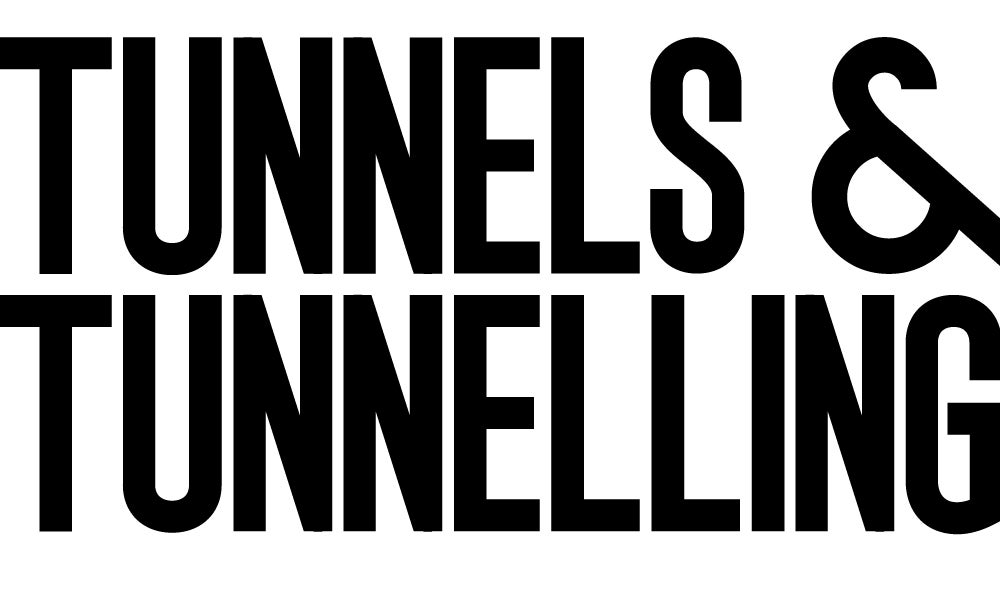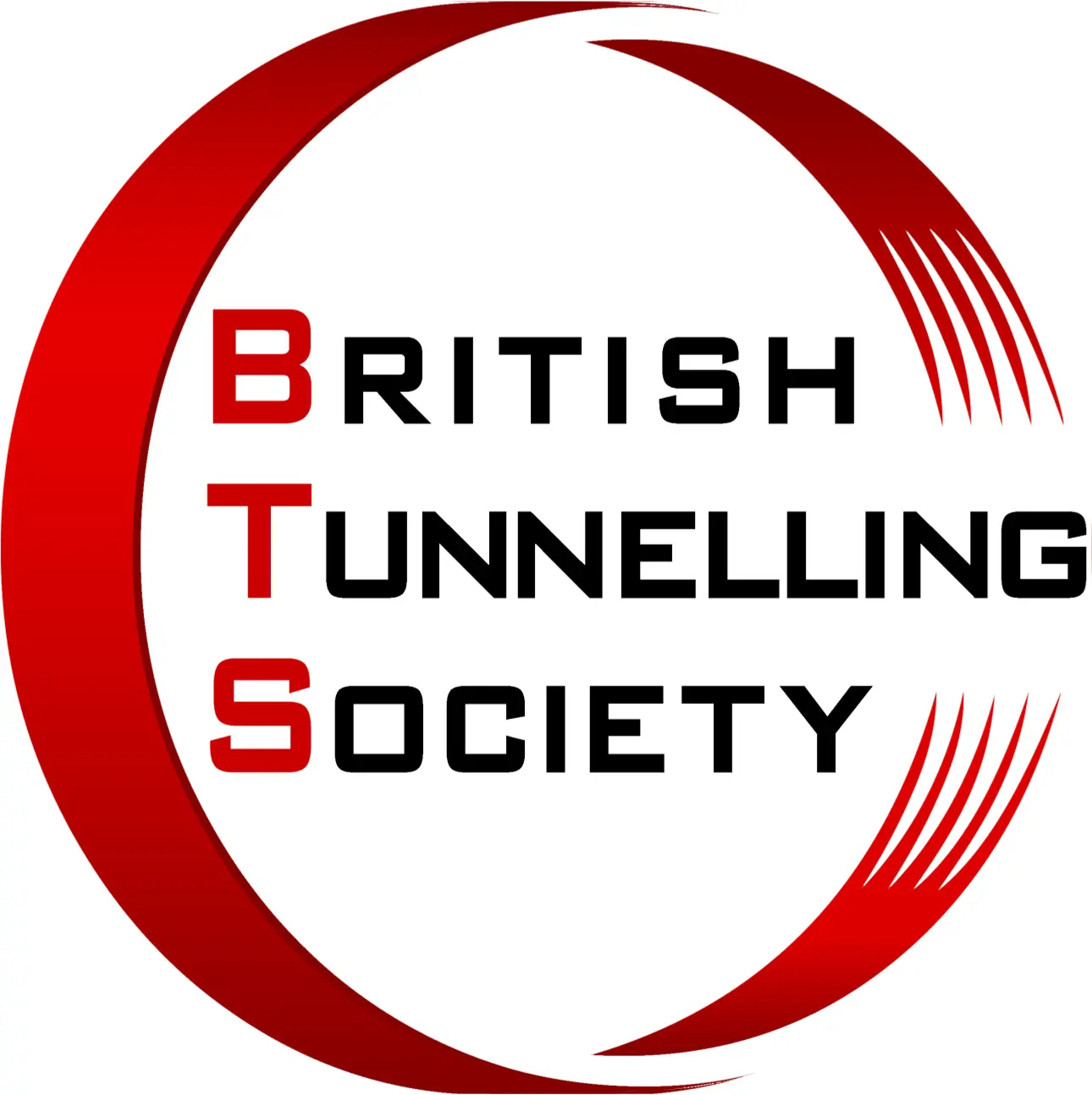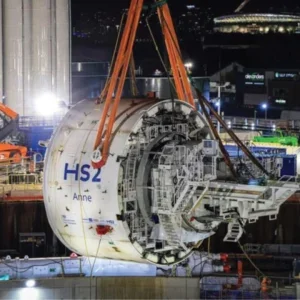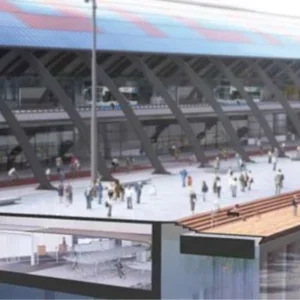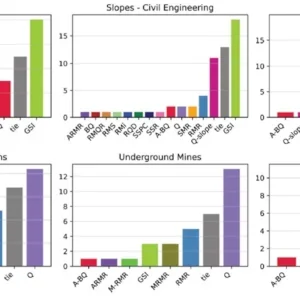This project includes the installation of an approximately 205m long, 1,200mm internal diameter (1,490mm outside diameter) concrete jacking pipe, using the microtunneling construction method. The casing pipe will house a new NPS 30 (762mm) carrier pipeline.
Enbridge Gas Distribution (Enbridge) is relocating an existing natural gas pipeline that currently crosses the Don River via a utility bridge located south of Eastern Avenue in Toronto, Ontario. The proposed pipeline crossing extends from east of the Don River within the loop of the Eastern Avenue on-ramp to the northbound Don Valley Parkway (DVP), to west of the Don River at the north end of Corktown Commons Park immediately east of Bayview Avenue.
The initial design solution was horizontal directional drilling. However, since the site is in a highly urbanized area, it is highly constrained, and available space for stringing the drag sections was considered inadequate.
Another crossing solution examined was to use Direct Pipe technology, a hybrid trenchless construction method which uses a thruster sited in a shallow trench to launch along a curved alignment a microtunnel boring machine (MTBM) attached to steel product pipe. However, following careful evaluation of the site constraints, local topography, and the required depth of installation to clear the retaining wall system supporting the Don Valley Parkway, this option was also eliminated.
Thus, the preferred construction method for installation of the pipeline at this river crossing was determined to be microtunneling and would be using 1,200mm inside diameter (1,490mm outside diameter) concrete jacking pipe.
While commonly used for the installation of on-grade gravity sewers, microtunneling is less common in oil and gas pipeline projects because a ‘two-pass’ construction method is required; first, the need to assemble and insert the carrier pipe in a deep vertical shaft; and second, the need for risers on either side of the crossing – among other technical challenges. Also, there are additional technical, permitting, and regulatory challenges to be encountered while planning and designing the proposed microtunneling installation. These include crossing critical transportation corridors, including the Don Valley Parkway (DVP) and the main Metrolink rail lines leading into Union Station; crossing the Don River; crossing multiple buried utilities; working near high voltage power lines; excavating/tunneling through highly varying geotechnical and hydrogeological conditions; as well as working in a TRCA-regulated area with existing and planned landforms used for flood control.
LOCAL TOPOGRAPHY, GEOLOGICAL AND HYDROGEOLOGICAL CONDITIONS
Four borings, BH1, BH2, BH3 and BH4, were completed along the proposed crossing alignment. BH1 is located near the launch shaft on the east side of the crossing; BH2 is located within the northbound lanes of the Don Valley Parkway; BH3 is located near the receiving shaft, at the west side of the crossing; while BH 4 was located approximately 35m north of the launch shaft on the east side of the crossing.
BH1 encountered silty clay and silty fill materials which were underlain by firm-to-stiff silty clayey sand, underlain by soft-to-very-stiff sandy clay to clay till, underlain by shale bedrock to a termination depth of 22.9m below ground surface (bgs) (56.7m elevation). Partially weathered bedrock was encountered at elevation 10.2m bgs, which transitions to weathered shale (poor-to-fair quality, very-close-to-close joint spacings). The groundwater level was observed at 4.9m bgs (74.7m elevation).
BH2 encountered fill materials comprising sand and clay with gravel; they were underlain by loose-to-compacted, moist, silty clay, underlain by firm-to-stiff sandy-clay till (moist) underlain by shale bedrock to a termination depth of 24.1m bgs (54.5m elevation). The partially weathered shale bedrock encountered at elevation 69.4m transitioned to unweathered shale (poor-to-excellent quality, close-to-moderate joint spacings). The groundwater level was not measured in this borehole.
BH3 generally encountered fill materials (sandy silt, silty clay and peat, moist-to-wet), underlain by very loose silty-sand with traces of clay and organics (wet, N-values 1-3, increasing to 9 at bottom of formation), underlain by loose to very loose sandy-silt to sand with silt (wet, N-values 1 to 6), underlain by soft-to-stiff silty clay (N values 2-9), underlain by loose-to-compacted sand with silt with trace gravel (approx. N7-12), underlain by inferred bedrock at 44.8m elevation (33.8m bgs), which also marked the termination of the borehole. The groundwater level was observed at 4.3m bgs (74.3m elevation). Two zones exhibited lower N-values, including the zone between elevations 74.5m and 68.6m (N =1-3, very loose sandy silt to silty sand) and the zone between elevations 62.3m and 56m (N = 1-3, loose sand to silt, soft silty clay).
The stratigraphy encountered in BH4 was similar to that reported for BH1, with fill (silty sand to sandy clay), underlain by silty-clayey sand (firm-to-stiff, moist-to-wet), underlain by clay till (firm-to stiff, moist), underlain by clayey sand with gravel. A partially weathered shale bedrock was encountered at elevation 70.7m, approximately 9.8m bgs. The borehole was terminated at elevation 68.3m, approximately 12.2m bgs. The groundwater table was found to reside at approximately 6.7m bgs.
Borehole data suggested that the microtunneling alignment begins in bedrock (partially weathered to weathered shale with limestone interbedding) and experiences a sudden transition towards the top of the east bank of the Don River, to a non-cohesive formation consisting of saturated, very loose to loose silty sand.
The bedrock elevation was suspected to drop sharply west of BH2, which will result in the microtunnel exiting from the rockface into a non-cohesive formation consisting of interbedded layers of very loose to loose sand to silty sand, potentially poorly graded and fully saturated. Figure 2 provides a summary of the boreholes as well as three possible transition profiles for the bedrock. Profile 3 will see the microtunnel unit potentially experiencing a buoyancy force as it exits the rockface, with the concrete pipe column still in solid rock, while Profile 2 translates into mixed-face conditions and associated steering challenges.
An additional concern was the hydraulic connectivity between the Don River and the western shaft (Figure 3), and the impact of the settlement associated with seepage/water drawdown on the Metrolinx tracks.
Solutions developed included an impervious, continuous caisson wall or secant piles extending 5-9m below the base of the shaft to reduce the effect of dewatering outside of the shafts and limit the drawdown and settlement concerns. Additionally, a tremie concrete plug will be needed to prevent ‘blow out’ of the shaft’s invert and flooding of the shaft.
EXISTING LINEAR INFRASTRUCTURE ELEMENTS
The project site is in a highly congested area along the Don River, with several utilities present both above ground and below. The proposed alignment crosses a railway operated by Metrolinx, the Lower River Trail, the Don River, the Don Valley Parkway (DVP), a retaining wall used to support the DVP, as well as the following buried utilities:
? 300mm watermain, 225-275mm oil pipelines, multiple telecommunication lines, two 150mm watermains, a 375mm sanitary sewer, multiple 200mm HONI line conduits, 950mm abandoned gas main, 525mm storm sewer, 450mm sanitary sewer and a 750mm gas main.
Near and over the jacking and reception shaft locations there are high voltage (550kV) overhead HONI lines, landforms used for flood mitigation, Bayview Avenue, and the Corktown Common Dog Park. The tower for HONI is situated approximately 15m from the reception shaft, presenting limitations on available vertical clearance above the shaft, and the type of lifting equipment that can be used to support construction of the western shaft.
SELECTION OF JACKING PIPE SYSTEM
Casing-pipe materials considered for the microtunneling installation were concrete jacking pipe, welded steel pipe and Permalok steel pipe. The different pipe types were compared through several design considerations, including hydrostatic loading, jacking load, encountered soils, corrosion, jointing method, material cost, water tightness, installation time, and shaft sizing. Table 1 provides a summary of the pipe-type comparison.
In summary, differentiation parameters among the three casing pipe options considered in this article include material cost, installation cost, installation time and shaft requirements. Costs of the Permalok pipe and the concrete jacking pipe were found to be similar, while welded steel pipe was found to be approximately 20% less. However, the material cost savings associated with the welded steel pipe material were expected to be more than offset by the expected installation costs, due to the time required for welding the entire circumference of the pipe and performing an x-ray inspection of each weld joint for the heavy-wall steel pipe. Additionally, inefficiencies may result due to paying the welding and jacking crews for a full day’s work for only a partial day’s productivity, as the two activities cannot be performed concurrently.
Overall, the cost of the Permalok and concrete jacking pipes is expected to be less per metre, require less effort for quality control during installation and result in shorter overall installation time.
Concrete jacking pipe was ultimately recommended for construction. It was selected because it is not only readily available in the Greater Toronto area, but also the nearby microtunneling contractors are familiar with this particular pipe product.
CONSTRUCTION PLANNING
Based on a careful review of the available geotechnical information, the centre line of the microtunneling drive was approximately at elevation 85.5m, maximising the drive length within the shale bedrock; this also provided a minimum of 2m clearance between the obvert of the jacking pipe and the termination of the sheet-pile retaining wall located at the western top bank of the Don River, and approximately 7m clearance from the bed of the Don River.
The microtunnel alignment transverses the silty sand formation beneath the Don River and its east bank, residing within the denser portion of this non-cohesive, granular formation (N values 6–9). The loose-to-very-loose silty-sand layers located above and below the target elevation of the microtunnel drive (N values 1–2) are considered undesirable from borehole and face-stability perspectives.
It was elected to use the shaft located at the east side of the crossing as the jacking shaft, due to higher accessibility, no height restriction, and significantly better subsurface conditions (cohesive soils underlain by bedrock). The approximately 15m-deep shaft was designed to have an internal diameter of 9.2m to support the microtunneling operations as well as the welding and insertion of the steel carrier pipe.
A tunnel-eye block was incorporated into the shaft design, with seal to be provided after removal of the eye block. The shaft wall was designed to support the 762mm (30in) carrier pipe riser, and accommodations were made for two 90-degree bends, each with a minimum bending radius of 5D.
An innovation incorporated by the contractor was to modify the shaft geometry from a circle to an oval, allowing for the full 9.2m-long major axis to accommodate the welding and insertion of the steel carrier pipe, while minimising the overall volume of soil excavated as well as the backfill operation.
The 8m-diameter receiving shaft was also designed to extend around 15m below the surface. Considerations for the retrieval shaft include removal of the MTBM, as well as accommodating the NPS 30 carrier pipe riser and the two 90-degree bends (5D min. bending radius); the need for water tightness; and the need to prevent ‘blow-out’ of the invert due to the hydrostatic head applied by the Don River.
An innovation incorporated by the contractor was to ‘beef-up’ the walls and floor of the shaft, such that the weight of the shaft equals the weight of the excavated soil, allowing the shaft to achieve neutral buoyancy. Doing this avoided the need for a cut-off wall extending to the bedrock.
The 205m-long casing pipe consists of 1,200mm internal diameter (1,490mm external diameter) concrete jacking pipe, rated to 7,100kN (concentric) and 4,500kN (eccentric) compressive axial loads. The joints were designed to resist an external hydrostatic head of up to 296kPa (43psi), and cushions were added between the joints to allow for uniform load transfer. Each third jacking pipe was equipped with bentonite injection ports to lubricate the interface between the pipe and the formation during installation, reduce required jacking loads and to keep the annular space around the circumference of the jacking pipe open.
It was desirable to incorporate multiple telecommunication conduits in the proposed tunnel, along with the 762mm (30in) carrier pipe. Thus, a 32mm utility conduit and four 100mm utility conduits were fixed to the crown of the 1,200mm concrete jacking pipe (see Figure 5). Neoprene spacers with four equally-spaced rollers around the circumference were specified to centralise the carrier pipe within the tunnel. The annular space between the carrier pipe and the jacking pipe was to be pressure grouted using flowable fill.
The heavy wall NPS 30 steel pipeline was to be lowered to the bottom of the jacking shafts in standard lengths of 6.1m, welded, x-rayed, sleeved, and inserted into the concrete casing pipe with the spacers.
Figure 4 shows a view of the assembly and insertion process of the NPS 30 carrier pipe at the bottom of the jacking shaft during construction.
Once the utilities are inserted through the casing, they will need to be brought back up to the tie-in elevation, approximately 3m below grade, using two prefabricated 90-degree bends. Pipe supports mounted on the shaft wall were designed to support the 762mm steel riser pipe.
A concrete benching was designed at the base of the shaft to withstand the anticipated operating forces. To decommission the shafts, the top two metres of shoring will be removed, the shaft backfilled with unshrinkable fill in predetermined lifts, and the surface restored to pre-construction conditions.
SUMMARY
The Don River microtunneling crossing to replace a NPS30 natural gas pipeline is a complex project with many construction challenges to overcome. At the time this paper was written, the microtunneling portion of the work was completed, and the contractor has been progressing with the welding and installation of the NPS 30 steel carrier pipe through the 1,200mm concrete casing pipe. This activity was expected to be followed by integrity testing of the new line, grouting of the annular space, tie-ins to the existing pipeline on both sides of the crossing, abandonment of the shafts and site restoration.
Typically, the project is affected by a series of design constraints due to the presence of numerous existing natural and man-made features.
